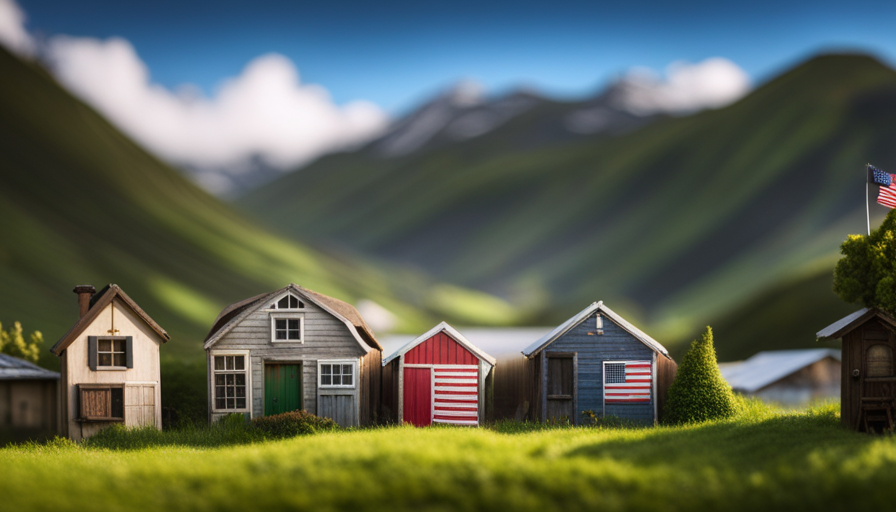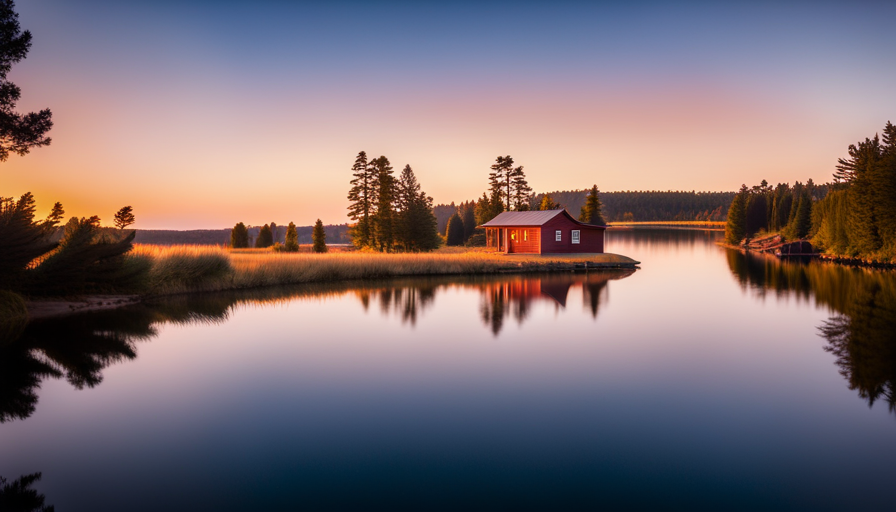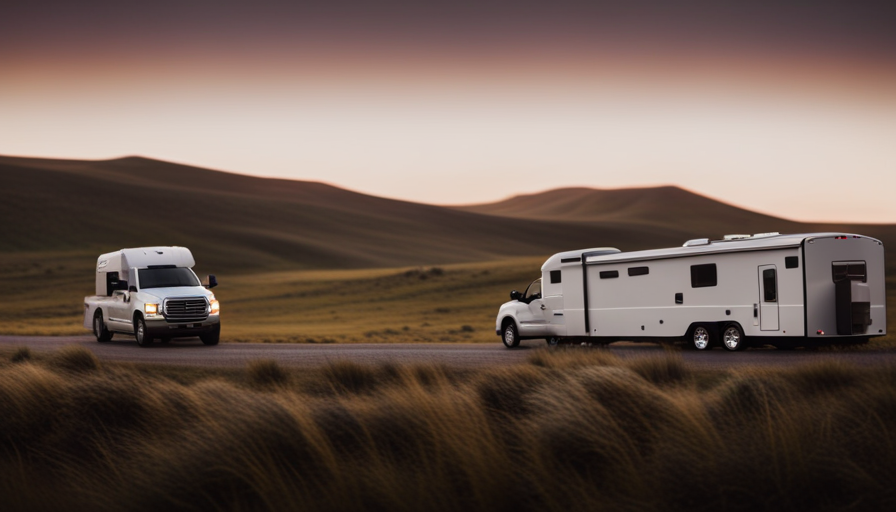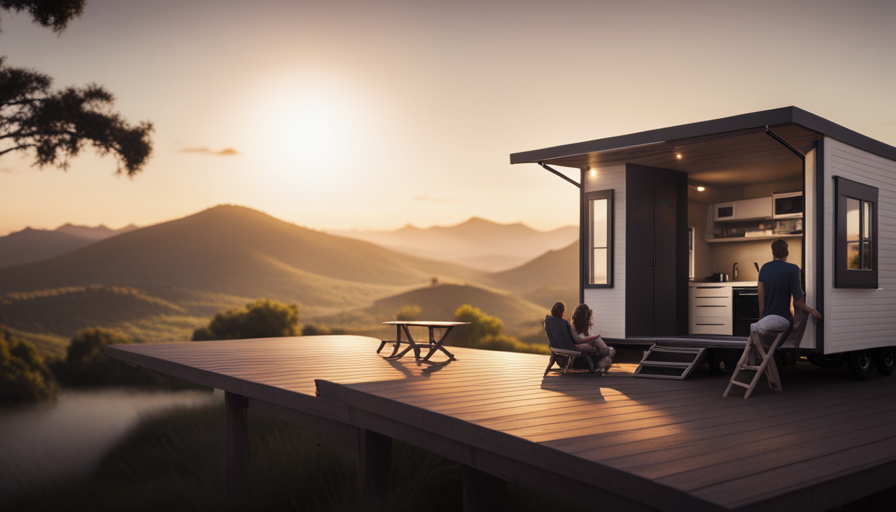Have you ever heard of Fortuna, California? Imagine this: a charming town of 12,000 residents, filled with a warm, small-town atmosphere. Considering parking your tiny house with all the necessary hookups in this picturesque location? Well, you’re in luck! You’ve struck gold!
Fortuna boasts several fantastic options for tiny house enthusiasts like myself. With its breathtaking natural beauty and proximity to the Redwood National and State Parks, Fortuna provides the perfect backdrop for your tiny house adventure.
In this article, I will guide you through some of the top choices for parking your tiny house with hookups in Fortuna. From the Redwood River Resort and Riverwalk RV Park to Shoreline RV Park and Fortuna Riverwalk RV Park, there are plenty of options to suit your needs and preferences. Additionally, Alton RV Park, Redcrest Resort, and Eel River Resort offer excellent amenities and stunning views.
Whether you’re a nature lover, seeking a peaceful retreat, or simply looking to embrace the tiny house lifestyle, Fortuna has something to offer everyone. So, let’s dive in and discover the best places to park your tiny house with hookups in this charming city!
Key Takeaways
- Fortuna, California offers a charming small-town atmosphere and is surrounded by the beautiful Redwood National and State Parks.
- RV parks in Fortuna provide a range of amenities, including electric and water hookups, Wi-Fi access, and laundry facilities.
- It is important to familiarize yourself with parking regulations for tiny houses in Fortuna before arriving.
- Fortuna offers a combination of natural beauty and modern comforts, with convenient shopping, dining options, and a vibrant arts and culture scene.
Redwood River Resort
You’ll absolutely love parking your tiny house with full hookups at the Redwood River Resort! Located in the picturesque Redcrest Resort, this charming campground offers everything you need for a comfortable and enjoyable stay.
The Redwood River Resort provides spacious sites with full hookups, including water, electricity, and sewer connections, ensuring that your tiny house has all the necessary amenities. The resort also offers beautiful views of the surrounding redwood trees and access to the nearby river, perfect for fishing or simply enjoying a peaceful stroll.
With its convenient location and fantastic amenities, the Redwood River Resort is the ideal spot for parking your tiny house.
Transitioning to the subsequent section about the Riverwalk RV Park, you’ll find another great option for tiny house enthusiasts.
Riverwalk RV Park
Riverwalk RV Park is a fantastic option for those looking for a scenic riverfront location to park their tiny house. Not only does it offer stunning views of the river, but it also provides full hookups and spacious sites for your convenience.
Plus, it’s close proximity to downtown Fortuna makes it a practical choice for exploring the city and enjoying all it has to offer.
Scenic riverfront location
Nestled alongside the picturesque riverfront, you can envision your tiny house with scenic views and convenient hookups.
This scenic location offers the perfect spot for a relaxing picnic by the river and endless opportunities for fishing enthusiasts.
Imagine waking up to the tranquil sounds of the flowing river and casting your line into the crystal-clear waters. With plenty of fishing spots nearby, you’ll have no shortage of places to explore and unwind.
And when you’re ready to retreat to your tiny house, you’ll be greeted with full hookups and spacious sites that cater to your every need. From electrical and water connections to waste disposal facilities, everything is conveniently available.
So, whether you’re a nature lover or simply seeking a peaceful getaway, this riverfront location has it all.
Full hookups and spacious sites
The full hookups and spacious sites at this scenic riverfront location will provide you with a comfortable and convenient escape. Whether you’re staying in an RV or a tiny house, you’ll have access to all the amenities you need at this RV campground.
From electrical and water hookups to waste disposal facilities, everything is taken care of for you. Plus, the spacious sites offer plenty of room for parking your tiny house and enjoying the surrounding nature. It’s important to note that there are regulations in place for parking tiny houses, so be sure to familiarize yourself with them before you arrive.
Once you’re settled in, you’ll appreciate the tranquility of this location while still being within close proximity to downtown Fortuna.
Close proximity to downtown Fortuna
Located just a stone’s throw away from downtown, you’ll have easy access to all the amenities and attractions that Fortuna has to offer. Whether you’re looking to explore the great outdoors or enjoy the local transportation options, this location has it all. Here are four reasons why this spot is perfect for your tiny house:
-
Outdoor recreation activities: Fortuna is surrounded by natural beauty, with hiking trails, fishing spots, and parks just a short distance away. You can indulge in activities like hiking, biking, and birdwatching without having to travel far.
-
Local transportation options: With the downtown area nearby, you’ll have easy access to public transportation, making it convenient to explore Fortuna and its surrounding areas. Whether you want to visit local attractions or sample the delicious cuisine, getting around will be a breeze.
-
Convenient shopping and dining: From quaint local shops to trendy restaurants, downtown Fortuna offers a wide range of options for your shopping and dining needs. You can explore the unique boutiques, grab a bite to eat at a cozy café, or indulge in some fine dining experiences.
-
Vibrant cultural scene: Fortuna is known for its vibrant arts and culture scene. From art galleries to live performances, there’s always something happening in this lively downtown area. You can immerse yourself in the local culture and take part in events and festivals throughout the year.
With all these incredible amenities and attractions just moments away, you won’t want to miss out on the opportunity to park your tiny house in this prime location. Now, let’s shift our focus to the Shoreline RV Park, another fantastic option for tiny house parking.
Shoreline RV Park
Park your tiny house at Shoreline RV Park, where you can enjoy all the comforts of home with full hookups and be just a stone’s throw away from the beautiful shoreline. Shoreline RV Park offers a prime location in Fortuna, California, making it an ideal choice for those seeking a convenient spot close to downtown.
This park is situated in close proximity to other popular attractions, such as the Redwood River Resort, providing you with endless opportunities to explore the breathtaking natural beauty of the area. With full hookups available, you can easily connect your tiny house to water, electricity, and sewer services, ensuring a hassle-free stay.
Don’t forget to take a stroll along the Fortuna Riverwalk RV Park, where you can immerse yourself in the tranquility of the surrounding nature.
Fortuna Riverwalk RV Park
I recently came across the Fortuna Riverwalk RV Park, a hidden gem nestled in a picturesque riverside setting with lush greenery. This park offers excellent RV hookups and facilities, making it a perfect spot for a relaxing getaway.
What I love about this park is its location, as it’s conveniently close to various shopping and dining options, allowing for a convenient and enjoyable stay.
Riverside setting with lush greenery
Imagine waking up to a riverside setting, surrounded by lush greenery, with your tiny house nestled amongst nature’s beauty. Fortuna Riverwalk RV Park offers the perfect location for riverside camping and outdoor activities.
You can spend your days hiking along the river, fishing in its clear waters, or simply enjoying the peaceful atmosphere while sitting by the water’s edge. The park’s lush greenery provides a tranquil backdrop for your stay, creating a sense of serenity and relaxation.
In addition to the natural beauty, the park offers a range of amenities and facilities to ensure your comfort and convenience. From full RV hookups to clean and modern facilities, you’ll have everything you need for a comfortable stay.
Transitioning into the next section about RV hookups and facilities, you’ll find that Fortuna Riverwalk RV Park provides all the necessary amenities for your tiny house living experience.
RV hookups and facilities
As we leave behind the breathtaking riverside setting with its lush greenery, let’s dive into the practicalities of RV hookups and facilities. When it comes to parking a tiny house with hookups in Fortuna, you’ll be pleased to know that there are several RV parks in the area that offer a range of amenities to make your stay comfortable. To help you choose the best option, I’ve compiled a table below detailing three popular RV parks in Fortuna and their key features. This will give you a clear idea of what each park has to offer, including the availability of electric and water hookups, Wi-Fi access, laundry facilities, and more. When planning your visit, keep in mind that the best time to experience Fortuna’s natural beauty and mild climate is during the summer months. So pack your bags and get ready to embark on an unforgettable adventure in Fortuna, where you can enjoy the perfect combination of nature and modern comforts. And speaking of modern comforts, the next section will highlight the convenience of being close to shopping and dining options.
| RV Park | Electric Hookups | Water Hookups | Wi-Fi Access |
|---|---|---|---|
| Park A | Yes | Yes | Yes |
| Park B | Yes | Yes | No |
| Park C | Yes | No | Yes |
Close to shopping and dining options
Conveniently located near the RV parks in Fortuna, you can easily satisfy your shopping and dining cravings. Fortuna offers a variety of shopping options to suit every need. From small boutiques to large supermarkets, you’ll find everything you need to stock up on essentials for your tiny house.
If you’re looking for dining choices, Fortuna has a range of restaurants, cafes, and eateries to satisfy any palate. Whether you’re in the mood for a quick bite or a leisurely meal, you’ll find plenty of options to choose from. After a day of exploring the beautiful surroundings, you can relax and indulge in a delicious meal without having to travel far.
Now, let’s move on to the next section about ‘Alton RV Park’ and discover its unique features.
Alton RV Park
When it comes to finding the perfect spot for your tiny house, Alton RV Park ticks all the boxes.
Its quiet countryside setting provides a peaceful retreat away from the hustle and bustle of city life.
With full hookups and spacious sites, you’ll have everything you need to enjoy a comfortable stay.
Plus, the pet-friendly and family-oriented atmosphere ensures that everyone in your household will feel welcome.
Quiet countryside setting
Nestled in a serene countryside, there’s a perfect spot to park your tiny house with all the necessary hookups. This quiet retreat offers a peaceful location, far away from the hustle and bustle of city life.
Here are four reasons why this tranquil countryside setting is the ideal place for your tiny house:
-
Privacy: Enjoy the solitude and tranquility of the countryside, surrounded by nature’s beauty.
-
Serenity: Experience the peacefulness of the countryside, where the sounds of chirping birds and rustling leaves replace the noise of traffic.
-
Fresh Air: Breathe in the crisp, clean air as you step outside your tiny house, rejuvenating your mind and body.
-
Scenic Views: Wake up to breathtaking views of rolling hills and picturesque landscapes, providing a sense of peace and calm.
In this quiet countryside setting, you’ll also find full hookups and spacious sites, ensuring a comfortable and convenient stay.
Full hookups and spacious sites
After searching for a quiet countryside setting, I am now focused on finding a place with full hookups and spacious sites for my tiny house. RV camping is all about convenience and comfort, and having access to full hookups is essential for a stress-free stay. I want to make sure I have electricity, water, and sewer connections readily available. Additionally, having spacious sites is important to me as I want to have enough room to relax and enjoy the outdoor space around my tiny house. To help you visualize the options, here is a table showcasing three campgrounds that offer full hookups and spacious sites:
| Campground | Full Hookups | Spacious Sites |
|---|---|---|
| Camp A | Yes | Yes |
| Camp B | Yes | Yes |
| Camp C | Yes | Yes |
With these options in mind, let’s move on to the next section to discuss the pet-friendly and family-oriented atmosphere.
Pet-friendly and family-oriented atmosphere
In addition to providing full hookups and spacious sites, these campgrounds also offer a pet-friendly and family-oriented atmosphere, making them ideal for a relaxing and enjoyable RV camping experience.
With pet-friendly accommodations, you can bring your furry friends along and let them enjoy the great outdoors with you. These campgrounds understand that pets are a part of the family and provide amenities like pet-friendly trails and designated areas for them to play.
Not only that, but the family-oriented atmosphere means that there are plenty of activities for everyone to enjoy. From playgrounds and swimming pools to organized games and events, there is something for every member of the family to enjoy.
So pack up your RV and head to these campgrounds for a memorable and fun-filled vacation.
Now let’s move on to the next section about Redcrest Resort, where you can experience even more outdoor recreational activities.
Redcrest Resort
For a delightful experience, look no further than Redcrest Resort for a perfect spot to park your tiny house with hookups. This pet-friendly and family-oriented resort offers a peaceful and scenic environment, perfect for a relaxing getaway.
Here are four reasons why Redcrest Resort is the ideal choice:
-
Beautiful Location: Nestled along the banks of the Redwood River, this resort offers stunning views of nature’s beauty. The towering redwood trees create a tranquil atmosphere that’s hard to beat.
-
Amenities: Redcrest Resort provides all the necessary amenities for a comfortable stay. With full hookups, you can easily connect your tiny house to water, electricity, and sewage services.
-
Activities: Whether you enjoy fishing, hiking, or simply exploring nature, there’s something for everyone at Redcrest Resort. Take a leisurely stroll along the river or cast a line and try your luck at catching some fish.
-
Friendly Staff: The staff at Redcrest Resort is warm and welcoming, ensuring that your stay is enjoyable and hassle-free.
With all these fantastic features, it’s no wonder that Redcrest Resort is a popular choice for tiny house owners. However, if you’re looking for an alternative, let’s head over to the next section about Eel River Resort.
Eel River Resort
If you’re searching for a peaceful and scenic getaway, look no further than Eel River Resort. Here, you’ll find a serene environment and endless opportunities for relaxation and exploration.
Nestled along the beautiful Eel River, this resort offers a tranquil setting surrounded by the stunning beauty of nature. With its convenient location near the Redwood River Resort, you’ll have easy access to both resorts and all the amenities they have to offer.
Eel River Resort provides everything you need for a comfortable stay, including RV hookups for your tiny house. You can enjoy the convenience of electricity, water, and sewer connections, allowing you to fully embrace the tiny house lifestyle without sacrificing modern comforts.
The resort also offers a range of recreational activities, such as fishing, hiking, and kayaking, ensuring there’s never a dull moment during your stay.
Whether you’re looking to unwind in nature or embark on exciting adventures, Eel River Resort is the perfect destination. Experience the beauty of the Eel River and the nearby Redwood River Resort while enjoying all the amenities and comforts of a modern tiny house.
Frequently Asked Questions
What are the amenities and facilities provided at each of the mentioned RV parks and resorts in Fortuna?
When comparing amenities and facilities at RV parks and resorts in Fortuna, it’s important to consider the pros and cons of parking tiny houses with hookups. Some parks may offer full hookups with water, electricity, and sewer connections, while others may only have partial hookups.
Additionally, amenities such as laundry facilities, Wi-Fi, and recreational activities vary among parks. It’s crucial to research and determine which amenities and facilities are essential for your needs before choosing a park in Fortuna.
Are pets allowed at these RV parks and resorts?
Are pets allowed at these RV parks and resorts? Let me tell you, finding a pet-friendly place is vital for any furry companion. Luckily, these RV parks and resorts understand that. They have pet-friendly policies in place, allowing you to bring your beloved pets along for the adventure.
Not only that, but there are also nearby attractions tailored for your pets, ensuring they have a great time too. It’s a win-win situation for everyone!
Do these RV parks and resorts offer long-term parking options for tiny houses?
Yes, many RV parks and resorts offer long-term parking options for tiny houses. They understand the growing popularity of tiny houses and have adapted their facilities to accommodate them.
These long-term parking options typically include utilities such as water, electricity, and sewage hookups. It’s important to check with each park or resort individually to confirm the availability of these amenities and any specific regulations or restrictions they may have.
Are there any specific regulations or restrictions for parking tiny houses with hookups at these locations?
Tiny house parking regulations and Fortuna RV park restrictions are a fascinating subject. It’s truly exhilarating to delve into the world of rules and limitations. But fear not, fellow tiny house enthusiasts, for I’ve done the research for you.
When it comes to parking your tiny house with hookups in Fortuna, there are a few regulations to keep in mind. RV parks typically have restrictions on the size and appearance of the tiny house, as well as rules regarding length of stay and utilities usage. So, before you park your little abode, be sure to familiarize yourself with the specific regulations of the Fortuna RV park you have in mind.
Can visitors make reservations in advance at these RV parks and resorts?
Visitors can typically make reservations in advance at RV parks and resorts. Reservation policies vary depending on the specific location, but many offer online booking options for convenience.
It’s advisable to check the availability and popular times, especially during peak seasons, to ensure a spot. Some places may have cancellation policies, so it’s important to understand those before booking.
Planning ahead and securing a reservation can help ensure a stress-free stay at these parks and resorts.
Conclusion
After conducting thorough research, it’s clear that Fortuna offers a variety of options for parking a tiny house with hookups.
From the scenic Redwood River Resort to the convenient Fortuna Riverwalk RV Park, there are plenty of choices for those seeking a comfortable and practical living space.
So, why wait any longer? Take the leap and find your perfect spot in Fortuna today.
With so many options available, the only question left is, where will you park your tiny house in this beautiful town?
Hi, I’m Emma. I’m the Editor in Chief of Tiny House 43, a blog all about tiny houses. While tree houses are often associated with childhood, they can be the perfect adult retreat. They offer a cozy space to relax and unwind, surrounded by nature. And since they’re typically built on stilts or raised platforms, they offer stunning views that traditional homes simply can’t match. If you’re looking for a unique and romantic getaway, a tree house tiny house might just be the perfect option.










